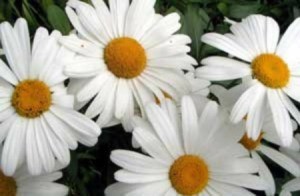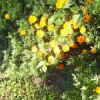 If you're new to planting flowers, you might want to plant perennials. They'll bloom every year without you having to replant them. So make the most of your planting time and dollars.
If you're new to planting flowers, you might want to plant perennials. They'll bloom every year without you having to replant them. So make the most of your planting time and dollars.
By T.H.
Many annuals will reseed themselves back, and come back every year. Some examples are Four 'o clocks. They will grow to about 3-4 feet high, and bloom all summer up to frost. You can collect the seeds and plant in other locations, also, but what drops to the ground will grow the next year. They come in various colors. I have "hot pink", but have seen them also in yellow and white. Portulaca is another self seeding annual. It also goes by the name Rose Moss. They spread out to fill in the bed and bloom all summer up to frost. Flower colors may vary, reds and yellows. Yet another is Periwinkle. They are usually white or pink. They are small plants and when they reproduce in the spring, may come in very thick and you can then thin and plant in other locations.
By Harlean
We live in a zone 3 here in southern Manitoba. I hate it when I go to the local Canadian Tire, Walmart, or Home Depot and they are selling zone 5 plants to unsuspecting customers. A new gardener would think that they, themselves, did something wrong when they planted it or watered it wrong, when the perennial does not come up next year, just as I did when I started to garden with perennials years ago.
This page contains the following solutions.
My husband and I have a lot of flower gardens in the summer. I have around 250 day lilies that I have collected, and am still collecting more. As the leaves are falling, we take a leaf blower and pick them up, which chops them.
Here are the questions asked by community members. Read on to see the answers provided by the ThriftyFun community.
I have two large, brick flower beds. What can I plant that will come up every year. I plant every year about Mothers Day! The cost is just too much anymore. I love pretty colors and no work. After twenty years of planting I need help. Thank you for any help!

I have good luck with all kind of bulbs, they come back every year, holly hock plants are also very nice. They reseed after they bloom, some do not bloom the first year.
You could plant bulbs this fall. There are so many bulbs to choose from now, if you choose the right ones, you could have blooms through summer.
For instance, crocus, hyacinths, and daffodils are usually the first bloomers in late winter/early spring, with daffodils being the latest to bloom of the three.
Then, of course, there are tulips and others that bloom early spring to late spring. Irises, gladiolas and many more will bloom well into the summer.
And then there are tubers, corms, and root stock that can be planted in the spring, will grow thru the summer, some blooming the first year. But they will die down in winter and come back every year. Two of my favorites are Hostas and Day Lillies. There are also Dahlias, many kinds and sizes of Allium, and just so many more, that will bloom til the first frost. Dahlias you probably would have to dig up and store over winter in your climate.
Perrenials are great, too, and again there are soooo many to choose from.There's also ground cover types, shrubs, climbers, small compact bush types, such as Veronica, and of course dwarf trees.
Just a few suggestions....maybe it'll spark some ideas.
Pat T of Nevada
I live in central Missouri and I absolutely LOVE my Hardy Mums. I have a number of colors and I tend to split them up -- that is transplant a bit of the root to another location in the yard -- every spring. They look dead at end of winter, but the tops just need to be trimmed off. They will be bright green all summer and bloom in the Fall. They require almost no attention at all here in Missouri once they have taken root. I get a whole yard full out of a few plants after a couple of years of splitting them up.
Good Luck!

If you want something that flowers continuously, try buying some "Flower Carpet Roses". I picked some up at the end of a season a few years ago, and they have gone crazy. They bloom all summer and into the fall (I had blooms until October and I'm from Michigan). They are very colorful and don't require much upkeep. I picked up more, but the ones that bloom the most are the pink and the coral. I get so many compliments on these roses!
If you want more information about Flower Carpet Roses, you can check out various websites.
I've copied the information from one website below. I've always picked them up at a local garden store, but you can also order online.
Flower Carpet Roses
For all those gardeners who love roses but have better things to do than spray, prune and fuss, Flower Carpet Roses were created. These low growing landscape roses bloom and bloom and bloom, providing brilliant swaths of color from late spring through fall. They are also some of the most disease resistant rose available anywhere.
Flower Carpet Roses offer lasting color, from bright accents in a section of the landscape, to a long curving border of horticultural technicolor. Equally at home in traditional borders, foundation plantings, along driveways and paths, and even in marginal embanked areas, these easy-care Carpet roses are the solution to dozens of landscaping scenarios. Choose your favorite color and add these beauties to your yard with full confidence that they'll look teriffic all season long. And for many, many seasons to come.
Please note: for reasons that nobody can explain Flower Carpet rose plants tend to vary in size by color each year. Some years the coral will be the largest plants and pink will be smaller, some years the yellow plants will be especially big and the red and white ones smaller. Please don't let this be the deciding factor for rose bushes you'll enjoy for years. All sizes grow quickly and the smaller ones will catch up in just the first season.
Daylillies, daffodils, iris, tall orange lillies, Stargazer lillies, zinnia (grown from seeds), tall sedums (fall color and butterflies), threadleaf coreopsis, shasta daisies, goldstrum rudbekia.
As you can tell I LOVE flowers and especially perennials. The above mentioned flowers are very easy to grow and will last for years. The zinnias are annuals, and you will have to replant from seeds each year, but the seeds are cheap. Be sure to prepare your soil well. Here in Kentucky we have alot of clay that dries like concrete in the summer. I go to the mulch place and get shredded bark (not cedar). I want something that will rot and feed my soil. I use that as a mulch, and then when it decays, I mix it into the soil and add more on top. It's much cheaper and better that buying bags of compost.
I think it depends on what zone of the US you live in. Try a website that sells flowers and there will be a link that shows the zone number of your state.
I live in Houston, TX USA and I think I'm zone 9 or 10 - I never can remember, but the site should show you what will thrive in your particular zone. Good luck!
Check out these photos.
We removed the turf from the postage stamps size areas of our lawn next to the house, and put in lots of stone and ground covers. Over the last few years, we have added many perennials along the odd wind chime and bubbler fountain.
Perennial plants come with so many beautiful colorful flowers and foliage, that they are a joy to use in designing your garden. Here are some helpful suggestions for planning perennial beds and borders to help you get the most of these versatile plants.
To keep your perennial flowers healthy and looking their best all season long, you need to get in the habit of scheduling some routine maintenance. Here are some strategies for upkeep that require minimal effort, allowing you to spend more time enjoying your garden, and less time working in it.
Because they will grace your garden season after season, choosing perennials for your garden can have an enduring effect on the overall appearance. Native plants are a good choice as are plants that do well in your area. Check neighbor's gardens, the local nursery, or contact a master gardener. This is a page about help choosing perennials.
Perennials can be used in numerous ways to keep your yard colorful throughout the year. This is a page about 10 perennials for a variety of uses.
This is a page about, "What is a Perennial?". The plants in your garden can be divided into two main categories, annuals and perennials. Perennials are those plants that will come up or leaf out every spring for at least several years.